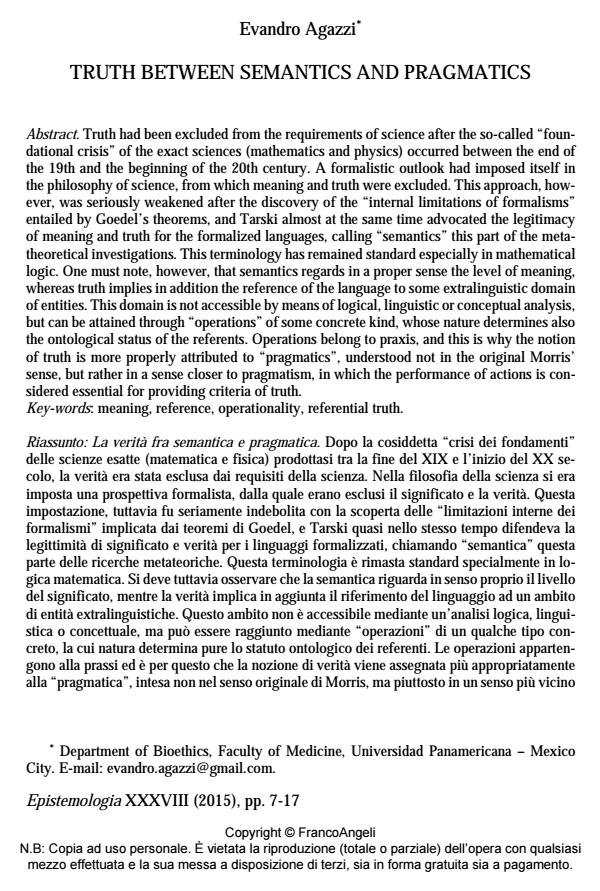Truth between semantics and pragmatics
Titolo Rivista EPISTEMOLOGIA
Autori/Curatori Evandro Agazzi
Anno di pubblicazione 2015 Fascicolo 2015/1 Lingua Inglese
Numero pagine 11 P. 7-17 Dimensione file 75 KB
DOI 10.3280/EPIS2015-001001
Il DOI è il codice a barre della proprietà intellettuale: per saperne di più
clicca qui
Qui sotto puoi vedere in anteprima la prima pagina di questo articolo.
Se questo articolo ti interessa, lo puoi acquistare (e scaricare in formato pdf) seguendo le facili indicazioni per acquistare il download credit. Acquista Download Credits per scaricare questo Articolo in formato PDF

FrancoAngeli è membro della Publishers International Linking Association, Inc (PILA)associazione indipendente e non profit per facilitare (attraverso i servizi tecnologici implementati da CrossRef.org) l’accesso degli studiosi ai contenuti digitali nelle pubblicazioni professionali e scientifiche
Truth had been excluded from the requirements of science after the so-called "foundational crisis" of the exact sciences (mathematics and physics) occurred between the end of the 19th and the beginning of the 20th century. A formalistic outlook had imposed itself in the philosophy of science, from which meaning and truth were excluded. This approach, however, was seriously weakened after the discovery of the "internal limitations of formalisms" entailed by Goedel’s theorems, and Tarski almost at the same time advocated the legitimacy of meaning and truth for the formalized languages, calling "semantics" this part of the metatheoretical investigations. This terminology has remained standard especially in mathematical logic. One must note, however, that semantics regards in a proper sense the level of meaning, whereas truth implies in addition the reference of the language to some extralinguistic domain of entities. This domain is not accessible by means of logical, linguistic or conceptual analysis, but can be attained through "operations" of some concrete kind, whose nature determines also the ontological status of the referents. Operations belong to praxis, and this is why the notion of truth is more properly attributed to "pragmatics", understood not in the original Morris’ sense, but rather in a sense closer to pragmatism, in which the performance of actions is considered essential for providing criteria of truth.
Dopo la cosiddetta "crisi dei fondamenti" delle scienze esatte (matematica e fisica) prodottasi tra la fine del XIX e l’inizio del XX secolo, la verità era stata esclusa dai requisiti della scienza. Nella filosofia della scienza si era imposta una prospettiva formalista, dalla quale erano esclusi il significato e la verità. Questa impostazione, tuttavia fu seriamente indebolita con la scoperta delle "limitazioni interne dei formalismi" implicata dai teoremi di Goedel, e Tarski quasi nello stesso tempo difendeva la legittimità di significato e verità per i linguaggi formalizzati, chiamando "semantica" questa parte delle ricerche metateoriche. Questa terminologia è rimasta standard specialmente in logica matematica. Si deve tuttavia osservare che la semantica riguarda in senso proprio il livello del significato, mentre la verità implica in aggiunta il riferimento del linguaggio ad un ambito di entità extralinguistiche. Questo ambito non è accessibile mediante un’analisi logica, linguistica o concettuale, ma può essere raggiunto mediante "operazioni" di un qualche tipo concreto, la cui natura determina pure lo statuto ontologico dei referenti. Le operazioni appartengono alla prassi ed è per questo che la nozione di verità viene assegnata più appropriatamente alla "pragmatica", intesa non nel senso originale di Morris, ma piuttosto in un senso più vicino al pragmatismo, secondo cui l’esecuzione di azioni è considerata essenziale per fornire criteri di verità.
Keywords:Significato, riferimento, operazionalità, verità referenziale
- Agazzi E. (2014). Scientific Objectivity and its Contexts, Cham / Heidelberg / New York /Dordrecht / London, Springer.
- Carnap R. (1942). Introduction to Semantics, Cambridge (Mass.), Harvard University Press (reprinted with Formalization of Logic in one volume in 1959). Gödel K. (1931). Ueber formal unentscheidbare Sätze der Principia Mathematica und verwandter Systeme I, Monatshefte für Mathematik und Physik, 38(1), pp. 173-198.
- Kokoszynska M. (1936). Über den absoluten Wahrheitsbegriff und einige andere semantische Begriffe, Erkenntnis, 6, pp. 143-165.
- Russell B. (1901). Recent work on the Principles of Mathematics, International Monthly 4, pp. 83-101.
- Russell B. (1917). Mysticism and Logic, London, Alwin & Unwin, 1917 (several reprints).
- Tarski A. (1933). Pojecie prawdy w jezykach nauk dedukcyjnych, Travaux de la Société des Sciences et des Lettres de Varsovie, Classe III Sciences Mathémathiques et Physiques, 34, pp. 116-136.
- Tarski A. (1935). Der Wahrheitsbegriff in den formalisierten Sprachen, Studia Philosophica, 1, pp. 261-405 (Engl. trans. by J.H. Woodger in Tarski A., Logic, Semantics, Metamathematics. Papers from 1923 to 1938, Oxford, Clarendon Press, 1956, pp. 152-278).
- Tarski A. (1936). Grundlegung der wissenschaftlichen Semantik. In Actes du Congrès International de Philosophie Scientifique, Paris, vol. III, pp. 1-8.
- Tarski A. (1944). The Semantic Conception of Truth and the Foundations of Semantics, Pilosophy and Phenomenological Research, 4, pp. 341-375.
Evandro Agazzi, Truth between semantics and pragmatics in "EPISTEMOLOGIA" 1/2015, pp 7-17, DOI: 10.3280/EPIS2015-001001